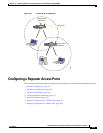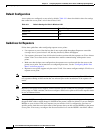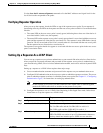
19-2
Cisco IOS Software Configuration Guide for Cisco Aironet Access Points
OL-29225-01
Chapter 19 Configuring Repeater and Standby Access Points and Workgroup Bridge Mode
Understanding Repeater Access Points
Understanding Repeater Access Points
A repeater access point is not connected to the wired LAN; it is placed within radio range of an access
point connected to the wired LAN to extend the range of your infrastructure or to overcome an obstacle
that blocks radio communication. You can configure either the 2.4-GHz radio or the 5-GHz radio as a
repeater. In access points with two radios, only one radio can be a repeater; the other radio must be
configured as a root radio.
The repeater forwards traffic between wireless users and the wired LAN by sending packets to either
another repeater or to an access point connected to the wired LAN. The data is sent through the route
that provides the best performance for the client. When you configure an access point as a repeater, the
access point’s Ethernet port does not forward traffic.
You can set up a chain of several repeater access points, but throughput for client devices at the end of
the repeater chain will be quite low. Because each repeater must receive and then re-transmit each packet
on the same channel, throughput is cut in half for each repeater you add to the chain.
A repeater access point associates to the access point with which it has the best connectivity. However,
you can specify the access point to which the repeater associates. Setting up a static, specific association
between a repeater and a root access point improves repeater performance.
To set up repeaters, you must enable Aironet extensions on both the parent (root) access point and the
repeater access points. Aironet extensions, which are enabled by default, improve the access point's
ability to understand the capabilities of Cisco Aironet client devices associated with the access point.
Disabling Aironet extensions sometimes improves the interoperability between the access point and
non-Cisco client devices. Non-Cisco client devices might have difficulty communicating with repeater
access points and the root access point to which repeaters are associated.
The infrastructure SSID must be assigned to the native VLAN. If more than one VLAN is created on an
access point or wireless bridge, an infrastructure SSID cannot be assigned to a non-native VLAN. The
following message appears when the infrastructure SSID is configured on non-native VLAN:
SSID [xxx] must be configured as native-vlan before enabling infrastructure-ssid
Note Because access points create a virtual interface for each radio interface, repeater access points associate
to the root access point twice: once for the actual interface and once for the virtual interface.
Note You cannot configure multiple VLANs on repeater access points. Repeater access points support only
the native VLAN.
Figure 19-1 shows an access point acting as a repeater.


















